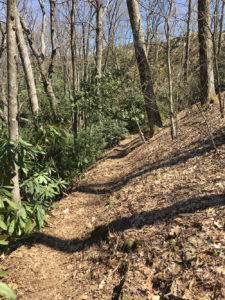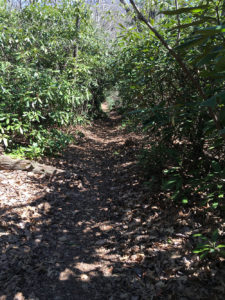“Does anyone know what day it is?” asks the young man trying to get a signal with his flip phone.
“SUNDAY!” comes the immediate reply.
One can’t really blame the fellow for not remembering. He’s hiking the Appalachian Trail.
Someone who chooses to take on all 2,168.1 miles of the Appalachian Trail will be at it for four to six months. Even weekend hikers or section hikers are out there for days or weeks at a time, following the white blazes that mark the trail, going uphill and downhill and uphill and downhill. It becomes its own world where the day of the week just isn’t all that relevant. More important is the next source of water, the next shelter or campsite, the next place to stop and have a meal.

On this particular Sunday, a half-dozen or so hikers make themselves comfortable around the picnic table in front of an AT shelter in Tennessee. It’s time for lunch – crackers, cheese, peanut butter, tuna in a foil packet. Stuff that can fit in a backpack, not weigh too much and not spoil too soon.
A few fire up their portable stoves – not much larger than a crushed soda can – for a hot meal or drink. Others will save that luxury for the evening once they’ve set up camp.
“I wish I had a tortilla,” sighs one fellow as he scoops tuna out of a packet. “I used to buy them, then I just stopped. I need to start buying them again.”
“I have an extra tortilla. You can have it,” responds another backpacker at the table.
“Thanks, but I couldn’t take it from you.”
“It’s an extra one. You can have it.”
That’s all the tuna-eater needed to hear. Tortilla now in hand, he happily spreads his tuna. He tops his treat with siracha sauce from a tiny bottle he carries with him – a move that draws the hiker equivalent of oohs-and-ahhs.
There’s a discussion about favorite Lance crackers. That leads to comparing favorite cheeses.
AT hikers talk a lot about food. And think a lot about food. And, especially, eat a lot of food.
An Appalachian Trail hiker easily burns 5,000 to 6,000 calories a day. So they’re always hungry, always ready to receive a spare tortilla or some extra Lance crackers or whatever else is available. Food is always a common language among the hikers.

They also share a uniform of sorts: Large backpack stuffed with tent, sleeping bag, rain gear, water purifier (the lightweight Sawyer Squeeze being the current favorite over the older, heavier pump filters) and, of course, food; a stove and fuel; a cup or pot. Outside the pack there’ll be a pair of Crocs hanging off, to be used in camp or while crossing a river, as well as a folded-up foam pad to provide some insulation from the hard ground or wooden shelter floor. Clothing is usually ragged tops and shorts – this day, one hiker sports a rain skirt – sturdy hiking boots or the newer, lighter trail runners.
At the same time, each has his or her – and there are more women hikers than ever – individual touches: blonde dreads. Close-shaved sides. Young-man beards – might be the first time they’ve seriously had one. Tats a plenty. Even a feather carefully poking out of one sock.
One of the few rules generally adhered to on the AT is “Hike Your Own Hike.” It’s one of the reasons to be out there.
The through hikers in this group will have walked 442.7 miles already, starting in the mountains of north Georgia, through the mountains of western North Carolina, through Smoky Mountains National Park into Tennessee. They have 10 more states and more than 1700 miles before completing the AT in Maine.
Today, they linger over lunch as we slower, weekend AT hikers press on. Soon, they’ll be passing us, with a friendly hello and “thanks again for the crackers. They were awesome.” And, later still, they can be seen relaxing near a spring. The next shelter is 3 miles ahead.